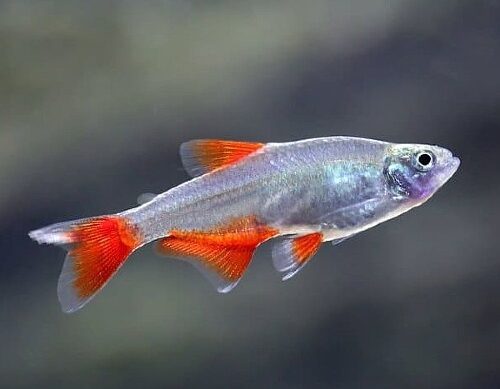Bloodfin Tetra, scientifically known as Aphyocharax anisitsi, is a captivating freshwater fish renowned for its vibrant appearance and tranquil demeanor. This article delves into the world of Bloodfin Tetras, exploring their physical characteristics, habitat, behavior, tank requirements, feeding habits, breeding techniques, health concerns, and essential tips for keeping them in your aquarium.
Introduction to Bloodfin Tetra
Bloodfin Tetras, originating from the river basins of South America, are a popular choice among aquarists due to their striking red fins and peaceful nature. These small-sized fish add a splash of color and vitality to any community tank, making them a favorite among beginners and experienced hobbyists alike.
Physical Description
Bloodfin Tetras exhibit a sleek and streamlined body, characterized by a translucent silver hue. Their defining feature lies in their namesake—vibrant red fins that accentuate their elegance. Typically, they grow to a modest size, reaching up to two inches in length.
Habitat and Distribution
In their natural habitat, Bloodfin Tetras thrive in slow-moving, heavily vegetated waters such as streams and tributaries. They are primarily found in the river systems of South America, including Argentina, Brazil, and Paraguay.
Behavior and Temperament
Bloodfin Tetras are known for their peaceful demeanor, making them excellent community fish. They prefer to swim in schools, providing a sense of security and reducing stress levels. When kept in groups of six or more, they showcase their natural schooling behavior, creating a mesmerizing sight in the aquarium.
Tank Requirements for Bloodfin Tetra
To ensure the well-being of Bloodfin Tetras, it’s crucial to replicate their natural habitat within the confines of an aquarium. A minimum tank size of 20 gallons is recommended to accommodate a school of these tetras. Additionally, maintaining stable water parameters with a temperature range of 72-78°F and a pH level between 6.0 and 7.5 is essential.
Diet and Feeding Bloodfin Tetra
Bloodfin Tetras are omnivorous by nature, exhibiting a hearty appetite for both plant matter and small invertebrates. In a home aquarium, they readily accept a varied diet comprising high-quality flake foods, freeze-dried bloodworms, brine shrimp, and vegetable matter. Regular feeding in small portions throughout the day helps mimic their natural feeding behavior.
Breeding Bloodfin Tetras
Breeding Bloodfin Tetras in captivity can be a rewarding experience for aquarists. To initiate breeding, create a separate breeding tank with dense vegetation and subdued lighting. Maintaining water conditions similar to their natural habitat, with slightly acidic to neutral pH and temperatures around 78-82°F, encourages spawning. Once the eggs are laid, remove the adult tetras to prevent them from consuming the eggs or fry.
Common Health Issues Bloodfin Tetra
While Bloodfin Tetras are relatively hardy, they are susceptible to common freshwater fish diseases such as ich and fin rot. Regular water changes, proper filtration, and a balanced diet contribute to their overall health and resilience. Quarantining new additions to the tank and practicing good hygiene minimize the risk of disease outbreaks.
Tips for Keeping Bloodfin Tetras
- Maintain stable water parameters through regular testing and monitoring.
- Provide ample hiding spots and vegetation to mimic their natural habitat.
- Avoid aggressive tank mates that may intimidate or harass the tetras.
- Perform routine tank maintenance, including water changes and filter cleaning, to ensure optimal water quality.
- Monitor their behavior and appetite regularly, as changes may indicate underlying health issues.
Conclusion
Bloodfin Tetras are a captivating addition to any freshwater aquarium, bringing color, charm, and tranquility to the aquatic environment. By understanding their habitat requirements, feeding habits, and social behavior, aquarists can create a thriving ecosystem that showcases the beauty of these magnificent fish.
ALSO READ:https://cafelam.com/
FAQs
Are Bloodfin Tetras suitable for beginner aquarists?
Yes, Bloodfin Tetras are beginner-friendly fish known for their hardiness and peaceful temperament. Making them an excellent choice for novice aquarists.
How many Bloodfin Tetras should I keep together?
It’s recommended to keep Bloodfin Tetras in groups of six or more to encourage. Their natural schooling behavior and reduce stress levels.
Can Bloodfin Tetras live with other fish species?
Yes, Bloodfin Tetras are peaceful community fish and can coexist with a wide range of compatible species, including other tetras, danios, and rasboras.
What is the average lifespan of Bloodfin Tetras?
With proper care and maintenance, Bloodfin Tetras can live for approximately three to five years in captivity.
How can I distinguish between male and female Bloodfin Tetras?
Male Bloodfin Tetras typically have a slimmer body and more vibrant coloration, especially in their fins, while females tend to be slightly rounder and less colorful.







